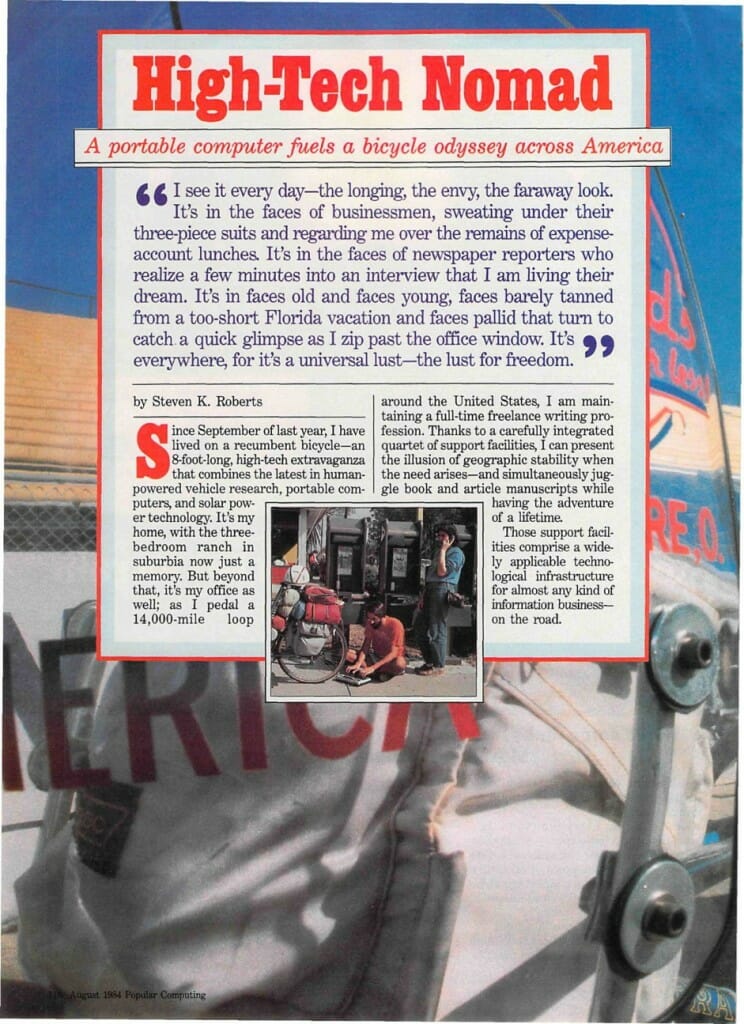
High-Tech Nomad – Popular Computing
This was one of the first substantial articles detailing my newly minted technomadic lifestyle, and it was enriched considerably by excellent photos. The piece ran 7 pages in what was then a high-profile personal-computing magazine, and laid out many of the defining principles of life as a paleo-technomad. For context, it’s worth remembering that back in 1984, people were still arguing about the viability of working at home… the road warriors and digital nomads we now take for granted had yet to materialize.

by Steven K. Roberts
Popular Computing
August, 1984
Photos: Dan Burden, Katherine Peden, and John Goell
A portable computer fuels a bicycle odyssey across America
I see it every day—the longing, the envy, the faraway look. It’s in the faces of businessmen, sweating under their three-piece suits and regarding me over the remains of expense-account lunches. It’s in the faces of newspaper reporters who realize a few minutes into an interview that I am living their dream. It’s in faces old and faces young, faces barely tanned from a too-short Florida vacation and faces pallid that turn to catch a quick glimpse as I zip past the office window. It’s everywhere, for it’s a universal lust—the lust for freedom.
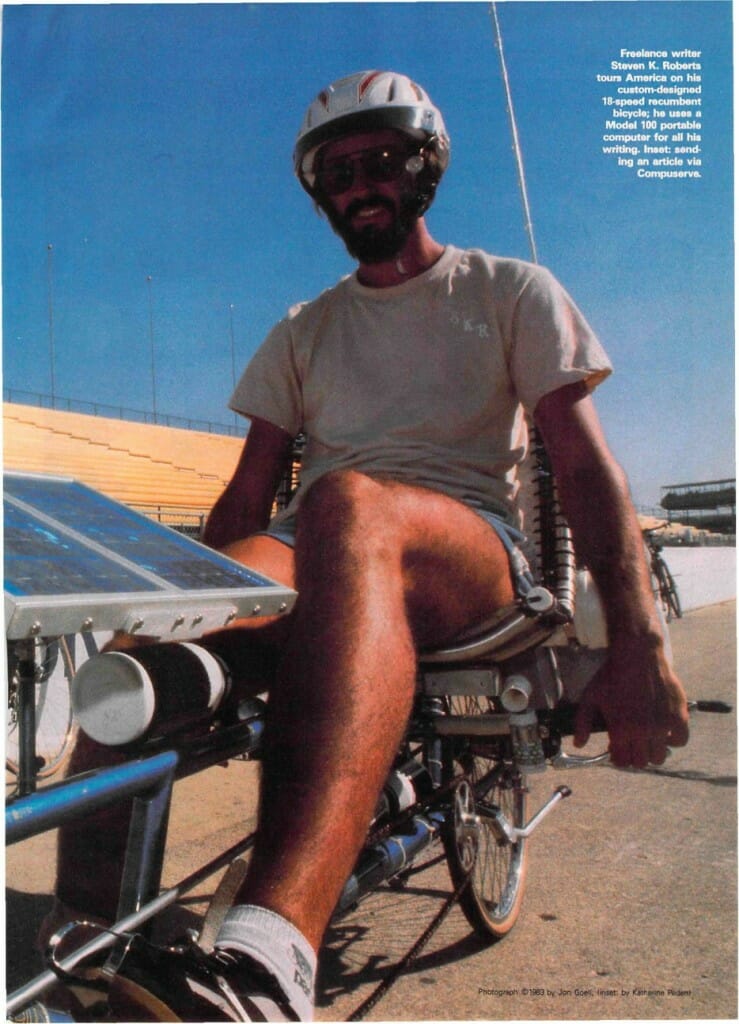
Since September of last year, I have lived on a recumbent bicycle—an 8-foot-long, high-tech extravaganza that combines the latest in human-powered vehicle research, portable computers, and solar power technology. It’s my home, with the three-bedroom ranch in suburbia now just a memory. But beyond that, it’s my office as well; as I pedal a 14,000-mile loop around the United States, I am maintaining a full-time freelance writing profession. Thanks to a carefully integrated quartet of support facilities, I can present the illusion of geographic stability when the need arises—and simultaneously juggle book and article manuscripts while having the adventure of a lifetime.
Those support facilities comprise a widely applicable technological infrastructure for almost any kind of information business – on the road.
Telecommuting
There has been a lot of talk in the last decade about the “electronic cottage,” or “telecommuting.” According to this theory, the availability of personal computers would eliminate the need for people to remain entombed in an office. They can take their work home and commute electronically.
This idea, when put in practice, has its flaws. Working at home can destroy the sense of community that is usually found in the office — and more than one would-be telecommuter has been driven back to the grind by the sheer loneliness of the spare bedroom. Also, the sense of being chained to a desk doesn’t necessarily go away just because you happen to own the desk.
But while the world has debated the viability of the electronic cottage, the technology on which it is based has continued to develop. It is becoming clear that one can work anywhere, not just at home. That anywhere can include the hotel rooms of a business trip, the cabin of a yacht, a beach, a friend’s kitchen table, or a motor home connected by various umbilical cords to a campsite in the woods. It’s no longer just a simple choice between office and home.
So let’s look at the essential ingredients of a nomadic business, and then see how they have come together to make my own high-tech adventure possible.
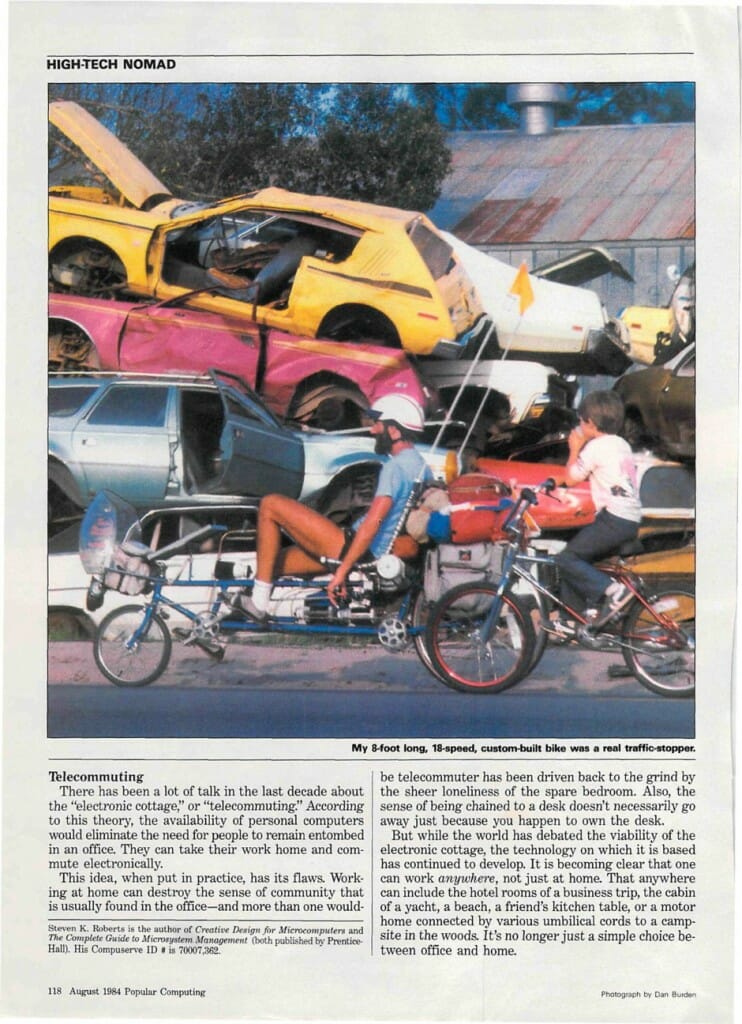
The Portable Office
Perhaps the most obvious component is the portable computer—in my case, a Radio Shack Model 100. Hot news six months ago, this 4-pound machine is now viewed as a “transition product” that will tide us over until the really robust portables start showing up. But even with its limitations, it is at least as much responsible for this trip’s success as is my bicycle. How else could I be spending this sunny winter afternoon pattering away on Broward Beach, the prime sunbathing spot for dorm residents at the University of Florida?
Of course there’s an obvious problem: file storage. A stand-alone Model 100 would hardly go very far toward maintaining a serious writing business. The memory would fill up halfway through the first feature-length article, and that would be the end of it. There is the unaesthetic and crude alternative of audio cassette storage, of course, and a Model 100-sized dual-drive 3.5-inch disk system with a CP/M file server is being created for me by Micromax as another solution to the problem. But the easiest method is the daily use of the second component, the CompuServe network.
The Network
My original reason for getting a CompuServe account (70007,362 here—pleased to meetcha) was simply to communicate with my assistant. This it accomplishes very neatly, but over the months I’ve been acquiring additional dedicated accounts as well—one for file storage, another for transferring manuscripts, another to support an on-line publishing venture, and a couple more for CB, and tinkering, and E-mail, and the special interest groups, and…
Yes. That’s what happens. The network ends up becoming dramatically useful in an enterprise like this, not only for the low-cost business communications that it provides but also for the maintenance of something approaching a stable social life. Even in a nodeless burg in the middle of nowhere, I can sign on to the CB simulator and find friends: “Hey Wordy! Where U B tonite?”
The combination of the portable computer and CompuServe, incidentally, offers occasional entertainment in my encounters with the public. I have become an agent of future shock. In Christiansburg, Ohio, I pulled up to the town’s only pay phone and dismounted. The bike gleamed; the Solarex photovoltaics were tilted to face the October sun. I sat cross-legged on the concrete with the Model 100 before me, dialed CompuServe’s number, and proceeded to upload a text file to my assistant in Columbus.
A dusty pickup truck rattled to a stop beside me, and an even dustier farmer squeaked open the door and stepped out. He walked slowly around the bike, quietly assimilating it, all the while thoughtfully chawin’ tobacco. Finally he squinted at me and spoke.
“Are yew with NASA?”
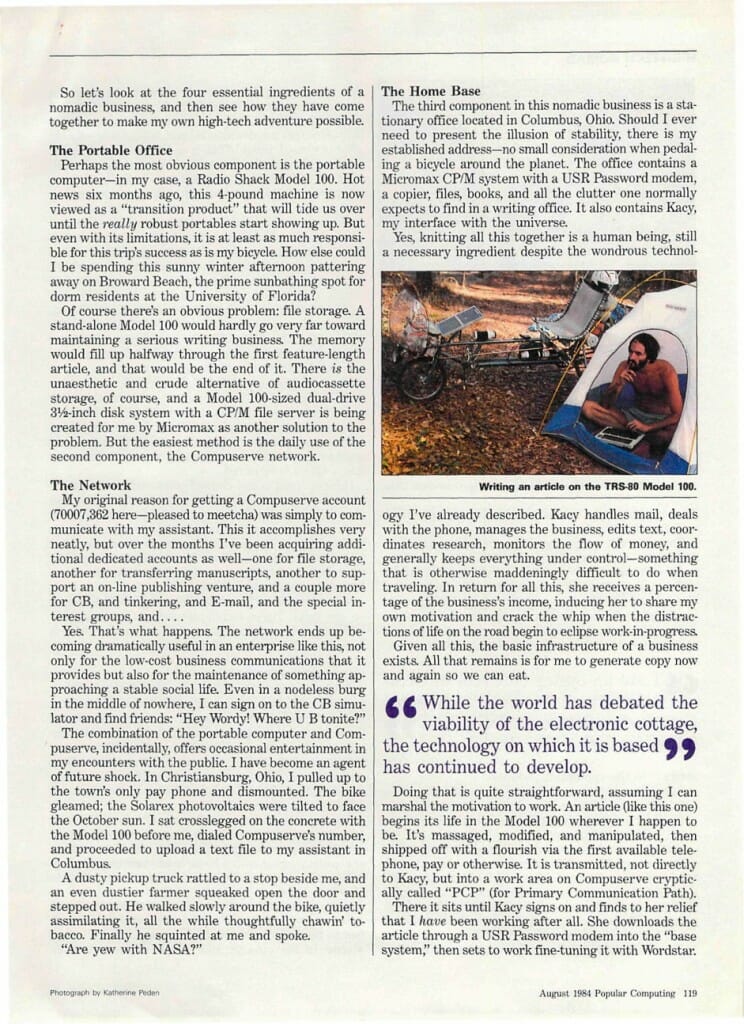
The Home Base
The third component in this nomadic business is a stationary office located in Columbus, Ohio. Should I ever need to present the illusion of stability, there is my established address—no small consideration when pedaling a bicycle around the planet. The office contains a Micromax CP/M system with a USR Password modem, a copier, files, books, and all the clutter one normally expects to find in a writing office. It also contains Kacy, my interface with the universe.
Yes, knitting all this together is a human being, still a necessary ingredient despite the wondrous technology I’ve already described. Kacy handles mail, deals with the phone, manages the business, edits text, coordinates research, monitors the flow of money, and generally keeps everything under control—something that is otherwise maddeningly difficult to do when traveling. In return for all this, she receives a percentage of the business’s income, inducing her to share my own motivation and crack the whip when the distractions of life on the road begin to eclipse work-in-progress.
Given all this, the basic infrastructure of a business exists. All that remains is for me to generate copy now and again so we can eat.
Doing that is quite straightforward, assuming I can marshal the motivation to work. An article (like this one) begins its life in the Model 100 wherever I happen to be. It’s massaged, modified, and manipulated, then shipped off with a flourish via the first available telephone, pay or otherwise. It is transmitted, not directly to Kacy, but into a work area on CompuServe cryptically called “PCP” (for Primary Communication Path).
There it sits until Kacy signs on and finds to her relief that I have been working after all. She downloads the article through a USR Password modem into the “base system,” then sets to work fine-tuning it with Wordstar. At some point, she deems it shippable and generates a clean manuscript.
From there, it can go one of two ways. More and more publishers welcome electronic submission of manuscripts—it’s much less work for everybody involved and reduces the potential for human error. In these cases, she retransmits the text, either through CompuServe or directly into the publisher’s own computer system. Some magazines still prefer traditional paper submissions, so for these she simply generates a hard copy and sends it to the appropriate address.
Every now and then, a change in specifications or a particularly awful piece of writing (yes, it can happen) will call for a rewrite. No problem—I just download the piece, edit it, and try again.
If all goes well, the article will eventually generate a bit of money. Meanwhile, of course, I have been spending furiously on the road. This calls for some cash management since we are, in the manner of most small freelance businesses, always performing a financial juggling act. This is another of Kacy’s jobs; she does battle while I strategize from a safe distance.
All of this implies considerable ongoing communication between my bicycle-borne office and the one in America’s heartland. The daily exchange of STEVE and KACY files in our CompuServe work area is our mainstay — files that are downloaded and deleted immediately after we read them. This is a simple and effective scheme: the disappearance of a file serves as acknowledgment of its receipt, and there is very little overhead (or on-line time) associated with storing and retrieving messages.
We discovered after a few months, however, that a random collection of “do this, do that” messages in the KACY files tends to become confusing. This is understandable, given the deluge of activity that sometimes floods that basement office in Ohio, and a solution was clearly called for. It turned out to be simple. We formulated a file containing a list of tasks to be completed, along with progress reports added by both of us. We manipulate this file with CompuServe’s FILGE—a vanilla-flavored line editor—eventually deleting an item completely when it is no longer active.
The combination of STEVE, KACY, DO, and various text files is an effective communication system through which all business matters are transacted: writing projects, new contacts and places to stay, financial matters, and the inevitable red-alerts. Our use of the telephone is minimal, generally occurring only when absolute maximum speed is required.
Personal mail is one class of communication that remains outside this system. Random correspondence can simply be opened and retransmitted electronically, but that would be inappropriate for letters of a more intimate nature. The solution is simple—I request that friends write “personal” on the envelopes of anything intended for my eyes only, and Kacy forwards these items to my current mail stop.
This takes care of the mechanics of day-to-day business on the road. These techniques enable me to appear stable if necessary (a rare requirement) and provide a framework for an active freelancing business.
Can Anyone Do It?
But how applicable is all this to others? Although few people can pull up roots in favor of a nomadic lifestyle, the combination of the technological infrastructure and these basic techniques can be profoundly liberating for almost anyone in an information profession.
A lot of people share a common problem—the serious disruption of business when, for whatever reason, they travel. This applies not only to full-time nomads like me, but to many others as well:
- the sales person or marketing rep who is on the road frequently or who often attends trade shows. These mobile folks have struggled for years with the problems of communicating with a home base—and they typically have the trunks of their cars crammed with all sorts of office clutter
- business executives who need to travel (or just like an occasional vacation) but find the time away from the office to be troublesome and inhibiting
- those in the obvious information professions (consulting, programming, media, marketing, lecturing and music) who operate primarily from a home base but travel extensively to see clients, perform, or do research
- retirees who are pursuing a lifelong dream of wandering but who need to manage investments, keep track of family businesses, or simply stay in touch with the folks back home
- the true work-at-home crowd, for whom these techniques can be liberating. Before abandoning central Ohio for a nomadic lifestyle, I spent months working in parks, restaurants, and friends’ homes—all with the intent of fine-tuning the techniques that would make full-time travel possible.
It seems, then, that a large percentage of the world’s business population shares a common set of concerns. Travel has always been a mixture of severe disruption and welcome relief from the daily grind. The costs of attending trade shows and visiting distant clients (or of just taking off for a week) have to include not only the obvious travel and accommodations expenses but also intangibles like the loss of business continuity, missed phone calls, and the vacation attitude of subordinates when the boss is away.
But networks, portables, a base system, and a handful of simple techniques can help you break the chains that have traditionally bound you to your desk. Let’s now have a look at my bicycle odyssey for an extreme example of this timely phenomenon.
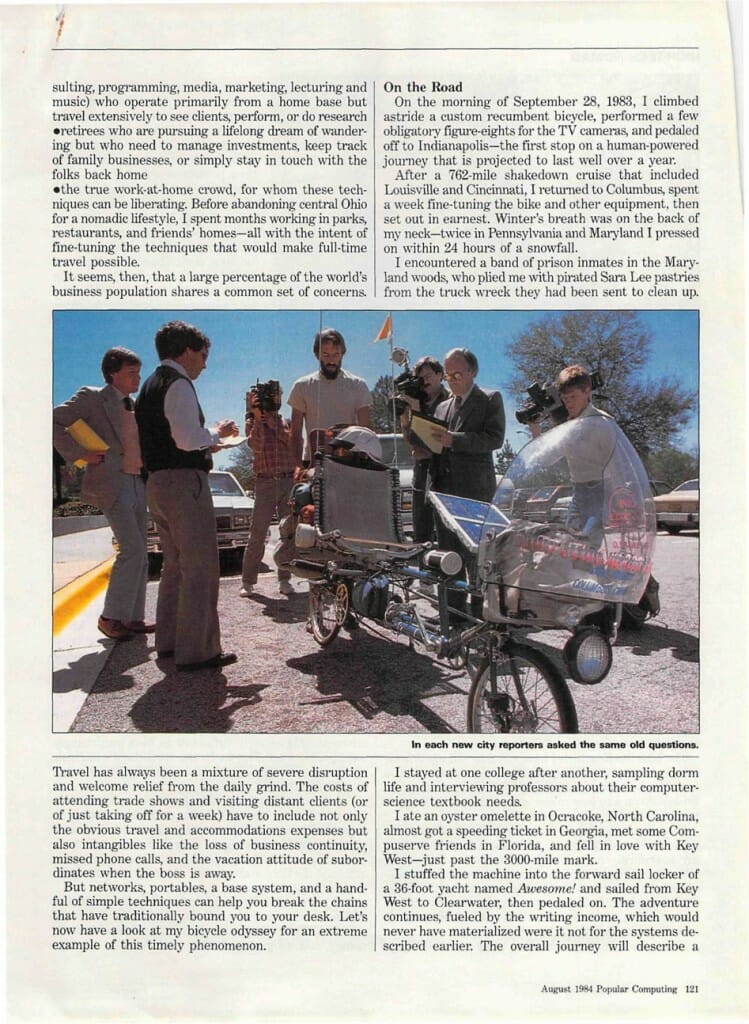
On the Road
On the morning of September 28, 1983, I climbed astride a custom recumbent bicycle, performed a few obligatory figure-eights for the TV cameras, and pedaled off to Indianapolis—the first stop on a human-powered journey that is projected to last well over a year.
After a 762-mile shakedown cruise that included Louisville and Cincinnati, I returned to Columbus, spent a week fine-tuning the bike and other equipment, then set out in earnest. Winter’s breath was on the back of my neck—twice in Pennsylvania and Maryland I pressed on within 24 hours of a snowfall.
I encountered a band of prison inmates in the Maryland woods, who plied me with pirated Sara Lee pastries from the truck wreck they had been sent to clean up.
I stayed at one college after another, sampling dorm life and interviewing professors about their computer-science textbook needs.
I ate an oyster omelette in Ocracoke, North Carolina, almost got a speeding ticket in Georgia, met some CompuServe friends in Florida, and fell in love with Key West—just past the 3000-mile mark.
I stuffed the machine into the forward sail locker of a 36-foot yacht named Awesome! and sailed from Key West to Clearwater, then pedaled on. The adventure continues, fueled by the writing income, which would never have materialized were it not for the systems described earlier. The overall journey will describe a ragged loop around the United States, very likely followed by a similar tour of Europe.
The bike itself—which I have come to call my Winnebiko in honor of its 135-pound load—is something of a tour de force of high-tech self-sufficiency. It can be broken down into four major components: bicycle, electronics package, office, and bedroom.
Bicycle: the conveyance upon which everything else depends is a custom-made recumbent bicycle, built to my specifications by Franklin Frames of Columbus, Ohio. Over 8 feet long from fairing to stern, it is a one-of-a-kind machine specifically designed for this trip. With its 18-speed wide-range derailleur, drum brake, under-seat steering, and unique frame geometry, this alone is a traffic-stopper.
Electronics Package: the first thing one is likely to notice upon peering at the machine is the array of solar panels on their ball-and-socket mount. These generate about 5 watts in full sun and charge the 12-volt, 4-amp-hour nickel-cadmium battery pack that in turn powers everything else. The computer is a very minor load—it will happily run for hours on its internal AA batteries when not plugged into the wall or the bike.
The major loads include a quartz-halogen sealed-beam headlight, a taillight and yellow flasher, a xenon strobe atop the flagpole, a CB radio for emergencies, a pager-type vibration-sensitive security system, a fluorescent tent light, and a yacht horn. The battery, radio, alarm, and charging circuitry are all located in an aluminum enclosure built into the white handlebar bag on the front of the bike. A wiring harness plugs into the side of that, and a pair of miniature panel meters display charge current and battery condition.
Office: the major component of the office, of course, is the Model 100, but it is augmented by a microcassette recorder with a remote microphone for dictation on the road, and a small assortment of file folders, stationery, etc. All that fits in a soft briefcase that packs atop the touring gear.
Bedroom: finally, there are the components that allow me to be reasonably dry and comfortable wherever I happen to be. Included are a dome tent, stove, the usual camping gear, stereo, rain suit, and clothes. The total weight of the system, fully loaded with water bottles full, is approximately 135 pounds. Considered heavy for a touring bike, but light for a mobile business, this actually turns out to be a surprisingly manageable load. Thanks to the recumbent’s intrinsic efficiency (and the 21-inch stump-pulling low gear), I haven’t had to walk a hill yet.
Needless to say after all this rhapsodizing, the system is working well. Work gets done, and life is a study in sheer exuberance, touched with madness, yet tempered by the realities of business. I lay over here and there to catch up on overdue projects—sometimes for weeks— and then the tires start to itch. The only cure is a good piece of asphalt.
So I say my good-byes, pack the office onto the bike, and pedal off once again, unfettered, seeking adventure, a nomad of the information age. It is a liberating technology, and it’s getting better all the time.


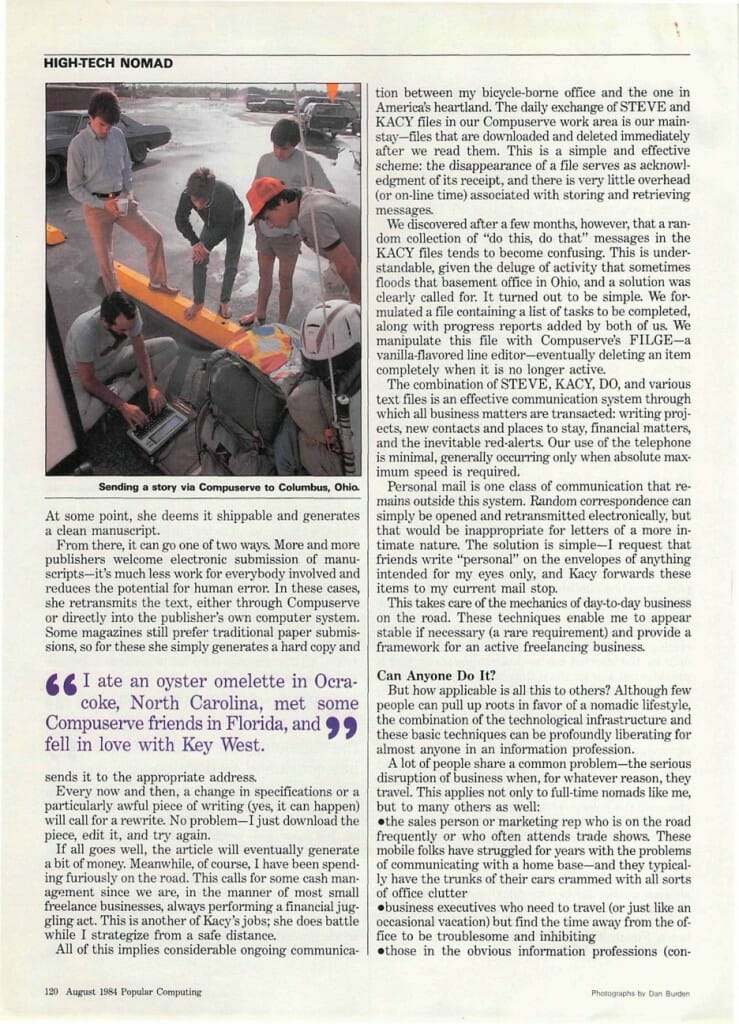
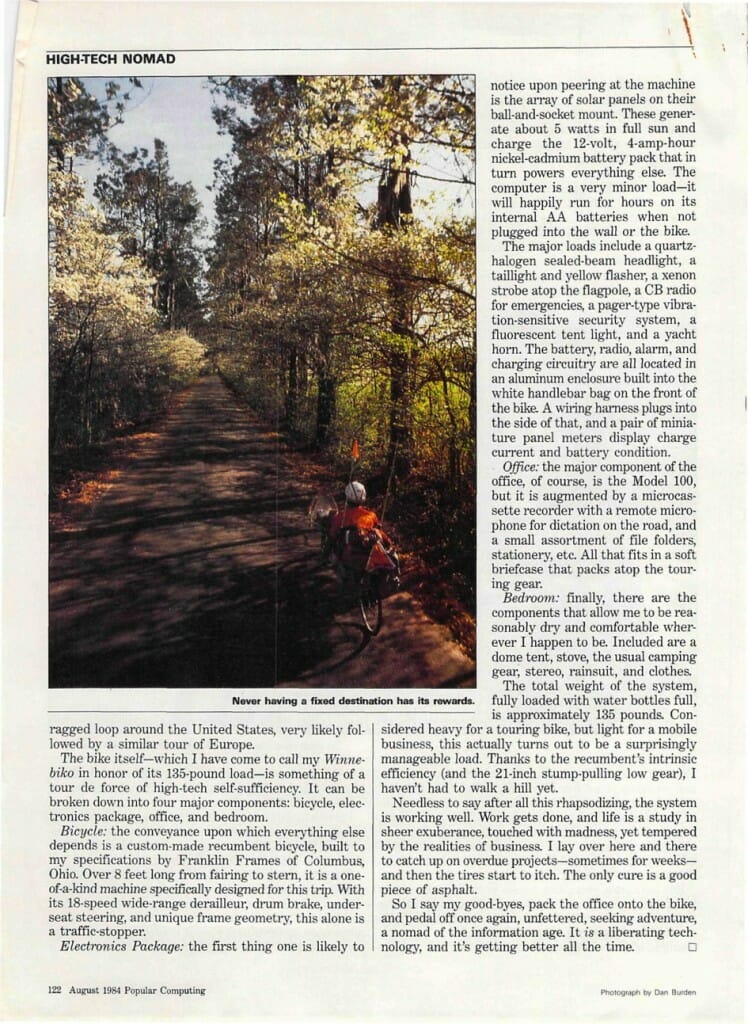
[…] to finish this boring topic off – here is the story of the first real digital nomad from way back in […]
[…] on a “computerized recumbent bicycle”, he becomes the very first digital nomad. He wrote an article that still influences and inspires the world of Nomadic […]
[…] all started, according to Gilbert, around 1983, with a freelance writer named Steven Roberts. Describing himself as a high-tech nomad, Roberts spent about a decade logging some 17,000 miles aboard a computerized recumbent bicycle […]
[…] the very first digital nomad — a guy named Steve Roberts who biked across America in 1984 while working from his Radio Shack Model 100 personal […]